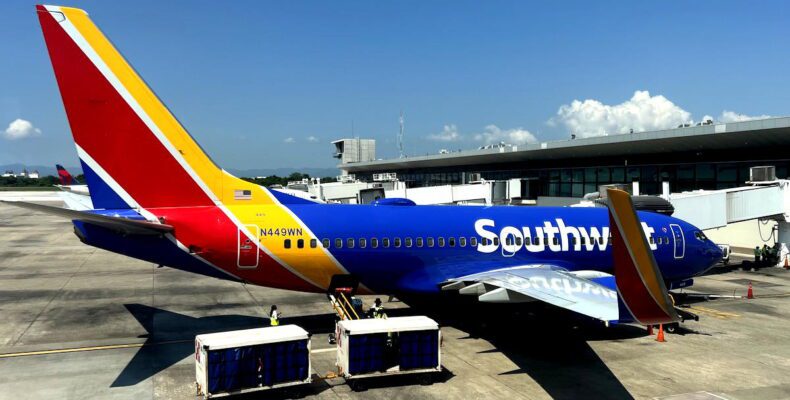Southwest Tops Bag Fee Charts, Battles Basic Economy Turmoil
Southwest Airlines is currently in the throes of a massive shake-up, reimagining everything from their business strategies to how we, the ever-patient passengers, experience flying. The Texas-based airline recently spilled the beans about their Q2 2025 financial happenings, and let’s just say, it’s the last glimpse of “old-ish” Southwest before they kick things into a whole new gear.
Southwest’s Financial Results: A Series of Unfortunate Events
Southwest’s Q2 2025 numbers are out, and they’re not exactly cause for celebration. Here’s how the figures stack up when matched against Q2 from the year before:
- Operating revenue comes in at $7.2 billion, a retreat of 1.5% from last year’s $7.4 billion
- Net income plummeted to $213 million, a steep drop of 42% from $367 million in 2024
- Total revenue per available seat mile slid to 15.41 cents, down 3.1% from 15.90 cents the previous year
- Load factor shrank to 78.5%, a decrease of 4% from last year’s 82.6%
- Operating expenses rose slightly to $7 billion, a 0.9% increase from $6.95 billion
The forward glance into Q3 2025 doesn’t quite promise fireworks either. The outlook suggests revenue per seat miles could dip 2% or rise by as much as the same, seat miles stay steady, and costs could jump anywhere between 3.5% and 5.5%.
The forecast sees “modest sequential improvement in demand,” which let’s face it, is not exactly poetic. With rising costs and stagnant capacity, where revenue might swing throws a spanner in the works. A sweet 2% increase in revenue per seat mile could soften the blow of rising costs, but a 2% dip paired with 5.5% higher costs? Ouch.
Flying these days could rival a high-altitude game of roulette, unless of course, you’re clinking glasses in Delta or United’s sky lounges. In recent years, the landscape of U.S. aviation has shifted more dramatically than the plot twists of your favorite thrillers, with premium and long-haul trips taking the lion’s share of profits. Southwest keeps its loyalty crown polished but is yet to delve into long-haul luxury or first-class comforts. Still, being in the black is better than being in the pits, a predicament many other domestic airlines can’t say they’re safe from.
The CEO’s proclamation about all this?
“We’re pushing through our transformation blueprint with gusto, implementing bag fees and basic economy, and our operations are slicker than ever—thanks to our stellar team. Our stuff’s rolling out fast, and early signs, especially on bag fees, are looking promising. Plus, with new offerings cropping up like greener grass, including assigned and premium seating for next year’s flyers, we’re tickled pink.”
“With a third of our $1.8 billion 2025 initiative EBIT goal already in the bag for the first half of this year, we’re chasing down the remainder with confidence, projecting serious momentum onward into 2026. And showing their penny-pinching prowess, our Board has unveiled a new $2 billion share repurchase plan, set to unfurl over the next couple of years.”
Bag Fees and Basic Economy: A Tale of Two Cities
Ready for more changes? It’s raining adjustments over at Southwest. The airline’s rolled out a slew of new features, including basic economy tickets and the controversial checked bag fees. More changes are on the way, with assigned and even extra-legroom seating coming soon.
So, what’s the financial ripple effect? Southwest reports their bag fees are raking in the dough better than predicted, without rocking the operational boat. How they measure this satisfaction is anyone’s guess.
Sure, bag fees might be showering them in coins, but how many have shunned flying Southwest because of them? The wide range in projected revenue per seat mile for Q3 2025—anywhere between down 2% and up 2%—poses a mind-boggling mystery.
There’s another twist. When Southwest rolled out basic economy in May 2025, they initially hit a snag with conversion rates nosediving. A swift pivot in their booking and marketing tactics, coupled with promotions, allegedly saw a return to expected booking levels.
Fantastic news, you’d think. Yet this little hiccup shaved nearly 0.5% off Q2 2025 year-over-year revenue per seat mile and is forecasted to chisel nearly 1% off Q3’s comparable metric.
Really, how do we make sense of it? Bag fee revenues are skyrocketing above expectations, while basic economy, the very root of these bag fees, seems to be dragging earnings down. Is something being lost in translation here, or is it textbook corporate code for “we’re guessing just as much as you are”?
Bottom Line
So, the verdict? Southwest’s cheque book tells a tale of shrinking Q2 profits—a tale all too familiar among airlines battling the unpredictable winds of recent times. Yet unlike the rest of the pack, Southwest is weaving a new narrative with its overhaul.
As we move forward, keeping an eye on these developments will be more engrossing than a binge-worthy series. The claim stands: bag fee gains are hearty while basic economy fare is a bit underwhelming on the earnings scale. How will it unfold? Time will tell.
Meanwhile, Val Seny ski resort might provide a different paradise for those who prefer to glide down snowy slopes rather than wade through airline fiscal reports.
